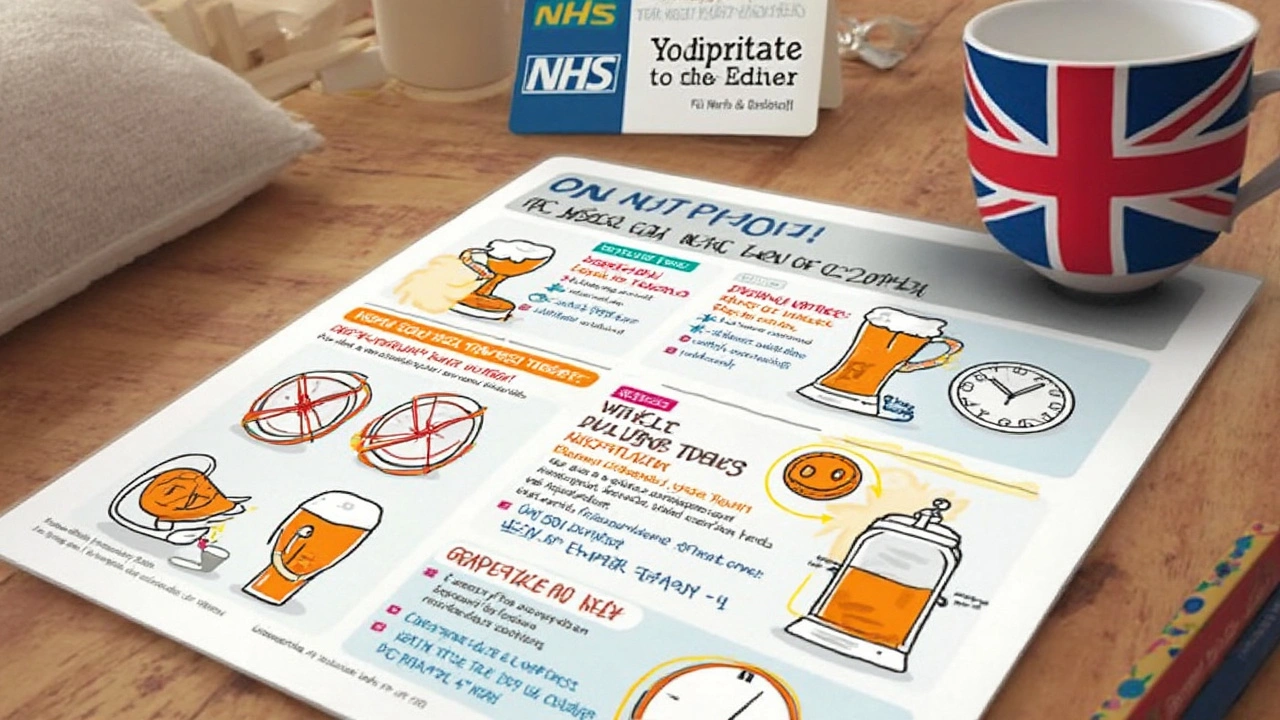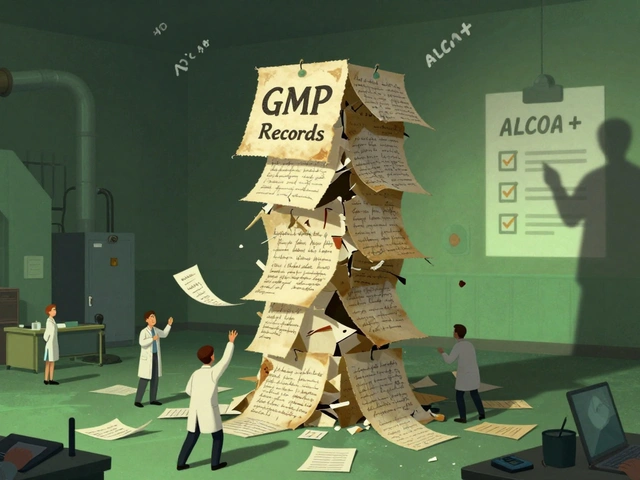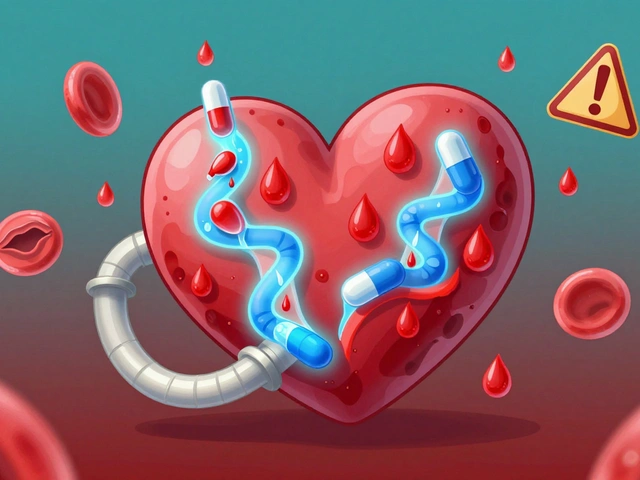
Most people don’t think about their cholesterol until a routine blood test brings it up. Suddenly, your doctor is tossing around drug names that sound like characters in a sci-fi movie. Vytorin is one of those names you might hear if your cholesterol numbers are high enough to worry about, but not high enough for a panic attack. In a world full of cholesterol medications, what makes Vytorin stand out?
What Is Vytorin and How Does It Work?
Here’s the easy version: Vytorin is a single pill that combines two proven cholesterol medicines—simvastatin and ezetimibe. Simvastatin is part of the statin family. It works by stopping your liver from making so much cholesterol. Ezetimibe does the cleanup job and limits how much cholesterol you actually soak up from the food you eat. Together, they attack cholesterol from two sides. If you’ve tried one cholesterol drug and it didn't do enough, or you just want something that goes the extra mile, this combo usually works better than either one alone.
If you check out data from the FDA and real-life studies, people taking Vytorin regularly see their LDL (that’s "bad" cholesterol) numbers drop 45%–60% on average. Not bad for a little white pill. And it doesn’t just lower cholesterol: there’s real data showing that Vytorin can lower your risk of heart attacks and other cardiovascular events, especially if you’re already at high risk.
The science behind it isn’t complicated, but it’s smart. Statins like simvastatin work in your liver. Ezetimibe does its job in your gut. Tackling cholesterol from both the production and the absorption sides gives you better odds at getting those numbers in check. That’s why doctors usually recommend Vytorin when simple statins haven’t done the trick or when someone needs a more aggressive approach right out of the gate.
If you’re curious about how Vytorin stacks up against using simvastatin or ezetimibe alone, compare the LDL reduction rates: simvastatin alone will get you somewhere between 25% and 45%, and ezetimibe alone averages about 18%. Adding them together in Vytorin pushes your results farther. And because it’s a combo pill, you only need to remember one pill, not two. That’s a win for anyone who forgets their meds (which is, let’s face it, all of us at some point).
There’s even a table with some actual numbers most people don’t get to see:
| Drug | Effect on LDL-C | Effect on HDL-C | Effect on Triglycerides |
|---|---|---|---|
| Simvastatin (alone) | -25 to -45% | +5 to +10% | -10 to -20% |
| Ezetimibe (alone) | -18% | +1 to +3% | negligible |
| Vytorin (combo) | -45 to -60% | +7 to +12% | -15 to -25% |
So, if you want to see a real bump in cholesterol control, the combo can’t be beat for simplicity and effectiveness.
Who Should—and Shouldn’t—Use Vytorin?
Not everyone with a cholesterol problem needs Vytorin. It’s usually suggested for folks whose numbers are still high even after diet changes, exercise, and a statin alone. Maybe heart disease runs in your family, or your doctor is really determined to keep your arteries squeaky clean after a heart attack or stroke. That’s when Vytorin makes sense.
There’s actually a specific group where doctors lean in on Vytorin. If you’ve got type 2 diabetes and a history of heart disease, doctors know that cholesterol control makes a big difference for you. And if your LDL just won’t budge with regular statins, Vytorin’s combo approach is a go-to.
But it’s not for everyone. Pregnant women? It’s a hard no. Cholesterol meds mess with how a baby develops, so doctors always switch women off statins (including Vytorin) if they’re pregnant or hoping to be. Same deal for nursing moms. If you’ve ever had liver disease, this combo can be risky since both drugs get broken down in your liver. Kidneys need to be watched, too, because simvastatin can stress them if you’re already dealing with kidney disease.
Some people have really specific cholesterol disorders passed down from their parents–familial hypercholesterolemia, for example. Even here, Vytorin sometimes does the trick, especially in the more common “heterozygous” type, though doctors still have to check your labs often to make sure your numbers improve safely. On the other hand, if you’re just slightly over the line from “normal,” your doctor might tell you to try lifestyle tweaks before jumping to this combo med.
Worth noting: drug interactions matter. Vytorin isn’t the best pick if you’re already taking certain heart or fungal meds (like amiodarone or itraconazole), strong antibiotics, or even grapefruit juice in large amounts. If you hear your doctor say "risk of myopathy," that’s them warning you that these interactions can cause rare but nasty muscle side effects.

Common and Surprising Side Effects of Vytorin
Every drug has a trade-off, and Vytorin is no exception. Most people don’t feel anything unusual, but it’s smart to know what could happen, just in case. On the mild side, you might notice a headache, mild tummy trouble (like diarrhea or belly pain), or a bit of muscle soreness when you first start taking it. These are usually temporary and go away after a few weeks.
The risk that gets doctors’ attention is muscles. Rarely, statins and their cousins like Vytorin can cause muscle pain, cramps, or weakness. The official term is myopathy—and in rare cases, something called rhabdomyolysis, which is much more dangerous, showing up as severe pain, very dark pee, or unexplained tiredness. If that ever happens, it’s hospital time. But the actual risk? Pretty low: less than 1 in 10,000 for rhabdo. Still, most doctors tell you to speak up if you notice muscle aches that just don’t quit or if you pee looks like cola.
Liver tests matter, too. Vytorin can slightly bump your liver enzymes, so doctors like to check your blood a few weeks after you start and maybe once a year after that. If you already have liver issues, expect to be watched more closely. Every once in a while, people complain of memory changes or feeling foggy, but that’s super rare, and sometimes it’s just a coincidence or something else causing forgetfulness.
A few other side notes: there’s a mild risk of increased blood sugar, so if you’re on the edge of diabetes, this is something to watch. Allergic reactions can happen but are so rare most doctors have never seen one. Also, the FDA flagged some possible cancer concerns years ago, but multiple big studies, including one in the New England Journal of Medicine in 2014, found no actual cancer risk from Vytorin use.
Still, the best advice is to listen to your body. If you notice weird muscle pain or a rash, talk to your doctor. They might tweak your dose or try another drug. Some users take coenzyme Q10 supplements, thinking it might help with muscle issues, though the science isn’t solid on whether it works. And if you ever have to suddenly stop the drug—like because of surgery—your cholesterol can bounce back up fast. The trick is to restart as soon as your doctor says it’s safe.
How to Get the Most Out of Vytorin
If you’re taking Vytorin, a few habits can help you get more benefit and avoid trouble. First off, try taking it at the same time each day, preferably in the evening, since cholesterol production ramps up at night. You don’t need food to make it work, but if the medicine upsets your stomach, try taking it with a small snack.
Don’t double up if you miss a dose; just take your next pill as scheduled. It’s easy to get fooled by the “more is better” trap, but the truth is, overdoing it just increases the risk of side effects and doesn’t “catch you up.” Set a phone alarm if you keep forgetting; building it into your bedtime routine makes it more automatic.
If your doctor tells you to avoid grapefruit or grapefruit juice, it’s real advice — grapefruit blocks an enzyme that breaks down simvastatin, so more drug sticks around in your system, raising side effect risks. And don’t start any new prescriptions, over-the-counter meds, or even supplements without checking about interactions. Even something that seems harmless, like St. John’s wort or certain antibiotics, can mess with how Vytorin works.
Eating right helps. Vytorin does the heavy lifting, but you’ll get better, safer results if you cut back on saturated fat, trans fat, and cholesterol in your food. Think more veggies, lean meats, and fiber. If you’re all-in, keep moving—exercise not only helps with your cholesterol but also bumps up your "good" HDL cholesterol.
Don’t forget regular checkups. People on Vytorin usually get at least one cholesterol blood test and liver function test every year, sometimes more often at the start. This isn’t just busywork; it helps track if the drug is working and if there’s any sign of trouble before you feel it. If you ever have to stop the drug temporarily (for surgery, illness, or another med), talk to your doctor about when to restart. Sudden stops can let your cholesterol drift up again.
Some people worry the drug will be for life. That’s not always true. If your cholesterol levels improve with a combo of medicine, diet, and exercise, sometimes the doctor can slowly taper the dose or switch to a single drug. The key is to stick to what works and check in regularly rather than just quitting on your own.
Insurance and cost can be a pain. Vytorin went generic a while ago, so most pharmacies can offer a lower-cost version (usually as ezetimibe-simvastatin). But prices vary, so it’s absolutely worth asking your pharmacy for options or using one of the popular pharmacy savings apps. People often save big by getting the generic combo or even just filling each drug separately.

Real Talk: Patient Experiences and What Doctors Really Think
Stories about cholesterol drugs are everywhere: you’ll find folks who swear Vytorin changed—maybe even saved—their lives. Then there’s the camp who didn’t notice a thing or only saw improved blood test numbers. In online reviews and forums, some share stories of finally getting their LDL into "goal range" after years of struggling with diet and other meds. A few mention that muscle aches faded after switching from a higher-dose statin to Vytorin’s lower-dose combo, which lines up with what doctors see in the clinic.
Doctors tend to be pragmatic about Vytorin: it works well, it’s safe for most, and it makes the job easier for people who need extra cholesterol management. The biggest negatives they mention are possible muscle and liver issues, so regular labs are a must. Many doctors actually prefer it for complex cases—like people with diabetes, or when statins alone aren’t enough—because it usually gets results without cranking up side effects as much as doubling the statin would.
Some folks get nervous about taking "two drugs in one," but most find it’s easier to remember just a single pill. Remember, there’s no magical number for how long you’ll need to take it. Your doctor can help figure that out based on regular test results and how your risk factors change over time. If you have questions, you’re not alone—most patients want to know how fast their cholesterol will improve (usually within 2–4 weeks), if their risk of a heart attack drops (yes, especially over time), and if side effects show up early (if they do, it’s usually in the first month).
There’s some stubborn myths floating around, too—like "statins are dangerous," or "you can just stop if you’re feeling fine." Those don’t line up with science or what doctors actually see. Studies keep showing that the benefits outweigh the risks, especially if you’re at real risk for heart or blood vessel accidents. Most folks tolerate Vytorin well, and almost everyone agrees you should get help if muscle aches, spotting in your pee, or ongoing tiredness pop up. Don’t go off the drug without a doctor’s input; it can undo months (or years) of good cholesterol work quicker than you’d guess.
All things considered, Vytorin is a powerful, practical tool when you need more cholesterol control than just lifestyle tweaks and a regular statin can provide. It’s not magic, but it’s proven to lower cholesterol and the risk of heart problems in most folks who use it as directed. If you’re ever in doubt, get another opinion and don’t be afraid to ask about generic options, side effect risks, or ways to cut drug costs. Your heart—and your wallet—will thank you down the line.






11 Comments
I found this overview on Vytorin really informative, especially the part about how it combines two mechanisms to lower cholesterol. It's fascinating how the drug works by blocking cholesterol absorption and also reducing cholesterol production in the liver.
I'm curious though, did anyone here experience side effects like muscle pain or digestive issues? How severe were they? Also, for someone new to cholesterol meds, how strict do you think one needs to be with lifestyle changes while on Vytorin?
The article mentions patients' experiences too. I think personal stories could really help others decide if this is a right choice. Would love to hear from people who have taken Vytorin long term.
/p>While this summary does a commendable job laying out Vytorin’s uses and side effects, I must assert that one should approach such polypharmacy with caution. The combination of ezetimibe and simvastatin, although effective in cholesterol reduction, inevitably increases the risk profile for adverse hepatic and muscular effects.
Moreover, I find that the pharmacodynamic nuances and biochemical pathways oftentimes remain insufficiently elucidated for the layperson. This can lead to misunderstandings about the necessity and safety of continued use.
It is imperative to ensure that any patient put on Vytorin undergoes rigorous monitoring for potential myopathy and liver function derangements, lest they fall victim to preventable complications under the guise of prevention.
What remains unclear to me is how the authors propose mitigating these risks beyond the cursory warnings presented here.
/p>Thanks for the detailed post! It’s great to see a medication breakdown without all the confusing jargon. I think for anyone dealing with cholesterol issues, understanding the ‘why’ and ‘how’ is crucial.
From what I’ve read and patients I’ve talked to, muscle pain can definitely be a common complaint. But sometimes it’s overlooked or dismissed. That’s why I advocate for open communication with your healthcare provider if you experience any troubling symptoms.
Also, lifestyle changes—like diet and exercise—shouldn't be brushed aside even if you're taking meds like Vytorin. They work best in tandem. Anyone else here balancing both?
/p>I really appreciate the clear guidance in the article about practical advice and what to avoid while on Vytorin. Combining medication with healthy habits is the key to managing cholesterol effectively.
One thing I’ve emphasized with folks I mentor is the importance of monitoring labs regularly. Not just LDL and HDL, but liver enzymes and muscle enzymes too. It's all about the holistic view of health, not just numbers on a chart.
I'd be interested to know how often doctors recommend these tests when someone starts Vytorin. And what about the long-term effects beyond cholesterol control? These are things we should all be mindful of.
/p>One cannot simply accept medications like Vytorin at face value without examining the broader pharmacological and sociopolitical context. Are we truly addressing the root causes of hypercholesterolemia, or merely medicating symptoms to enrich pharmaceutical conglomerates? The mechanistic action—blocking cholesterol absorption and synthesis—is elegant in theory but masks a deeper systemic issue.
I urge anyone reading this to consider the biochemical cascade triggered by these agents and the unforeseen consequences thereof. Muscle toxicity is just one tip of the iceberg.
Also, the patient experiences glossed over in these summaries rarely capture the full spectrum of adverse events. Vigilance and skepticism are warranted when embracing such combination drugs.
/p>Following up on the muscle pain topic, I read that it might be more common than we realize, especially when Vytorin is combined with other medications. Has anyone else noticed a pattern with specific drug interactions?
It’s so important to keep an open dialogue with your doctor about all medications and supplements you take. Sometimes even over-the-counter drugs can affect how these cholesterol meds act.
Does anyone have tips for managing side effects without stopping the medication? Would love to hear your strategies.
/p>Great point on interactions! I always encourage people to create an updated medication list before any appointment. It provides a clearer picture of potential conflicts.
In terms of side effect management, hydration, moderate exercise, and sometimes adjusting the dose can help. But absolutely, decisions need to be personalized and guided by a healthcare professional.
Also, patience is key; some side effects may lessen as your body adjusts. But persistent or severe symptoms deserve prompt evaluation.
/p>Honestly, I remain dubious about the whole cholesterol-medication complex. The way Big Pharma pushes combination pills like Vytorin just screams profit over patient well-being to me. Are we sure all these side effects, especially the ones that pop up over years, aren’t being downplayed?
People should definitely pressure their doctors for second opinions and alternative therapies. Also, any thoughts on supplements versus meds? Sometimes natural approaches seem safer.
Anyone else suspicious of how quickly these drugs get approved and marketed globally?
/p>I get the concerns about pharma, but it’s important to remember that for some people, drugs like Vytorin do make a huge difference in preventing serious cardiovascular events.
Of course, lifestyle is vital, but medicine isn’t one-size-fits-all. Some folks genetically need that medication boost. I encourage open dialogue, informed consent, and vigilant monitoring to maximize benefits and minimize harm.
It’s all about balance and being proactive about your health journey.
/p>The paranoia about Big Pharma aside, I find the general public is often too lazy to make lifestyle changes and turns to meds as a crutch. It’s frustrating to see how medication is often prescribed without emphasizing diet and exercise.
Those side effects? They’re not always mild and are conveniently tucked away in patient leaflets most won’t read. We need harsher disclosure and stricter evaluation of long-term impacts.
People need to demand more transparency and accountability before popping pills like candy.
/p>From a more analytical perspective, the article does a credible job of simplifying Vytorin's clinical efficacy and pharmacologic basis. Yet, it skirts the intricate molecular pharmacokinetics and disregards the wider sociological implications of cholesterol management through pharmaceutical intervention.
One cannot help but observe the hegemonic discourse promulgated by Western medicine which valorizes biochemical manipulation over holistic approaches. This narrow focus eclipses the multifaceted etiology of dyslipidemia, sidelining genetic, environmental, and behavioral determinants.
Nevertheless, the practical advice enumerated here could be pragmatically beneficial for the lay public navigating the complexities of cholesterol therapy.
/p>